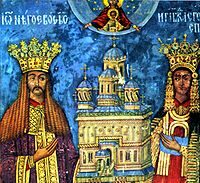Iuliana Dumitrașcu, National Museum of Art of Romania
On the eve of the sixteenth century, Wallachia was a site of cultural transfers, a buffer between the Ottoman and Christian worlds, facilitating the mobility of people and goods as well as ideas. Neagoe Basarab (1512-1521) began his reign at this crossroad of influences. He is said to have been guided in his political affairs by the ideology of the Byzantine emperors while leading a Renaissance lifestyle. The documents of his chancellery offer us a glimpse of his active presence, though mostly through his ambassadors, between Rome and Constantinople, via Venice and Budapest, when pressing political issues were being discussed, while the few surviving material testimonies of his era give us a glimpse of the multicultural environment in which he lived: kaftans of sumptuous Venetian and Florentine velvets, liturgical silverware combining Gothic and Byzantine elements, and a foundation that defies any stylistic categorization: the Monastery of Curtea de Argeș.
Iuliana Dumitrașcu is Curator of Medieval Art at the National Museum of Art in Romania.
